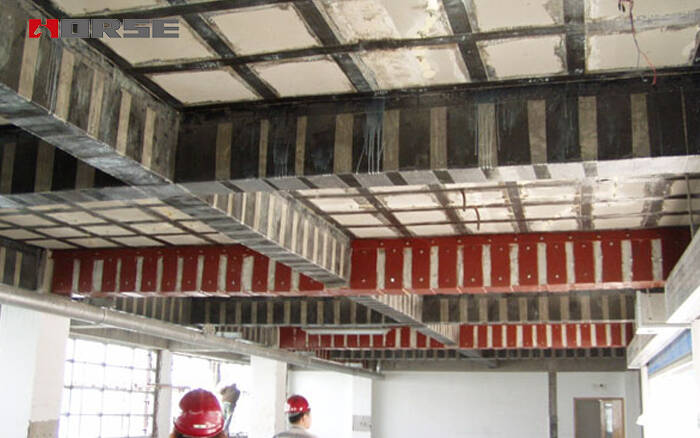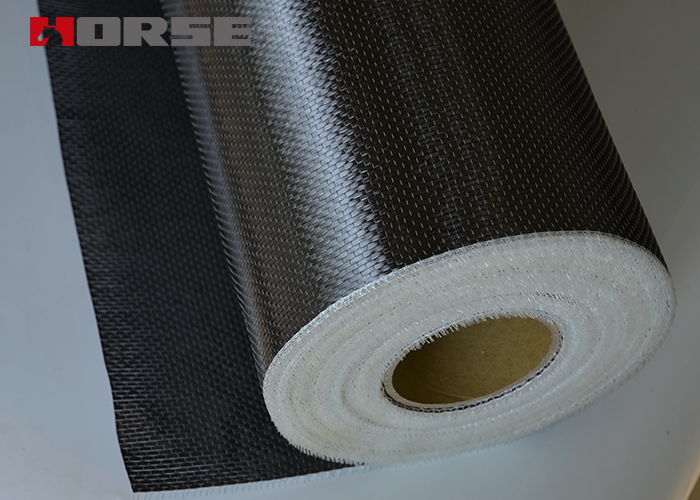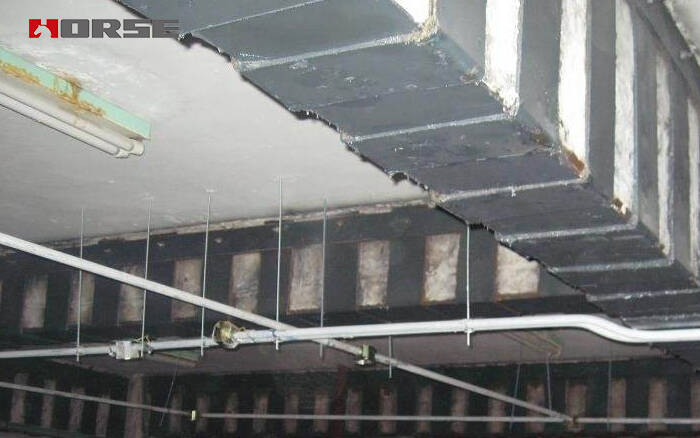Solutions
Horse Construction offers full range of structural strengthening materials with technical supports, documentation supports, products supports, project supports.
Can Carbon Fiber Reinforcement Replace Bonded Steel Plate?

Carbon fiber cloth reinforcement and bonded steel reinforcement have many similarities, so can they be replaced in practical applications?
01
The similarities between sticking carbon cloth and sticking steel
From the scope of application, carbon cloth and bonded steel can also be used for bending members, large eccentric compression members and tension members. For example, sticking carbon cloth or steel plate at the bottom of the beam can improve the bearing capacity of the structure and achieve the purpose of reinforcement. In addition, in principle, both carbon cloth and bonded steel use structural adhesive to stick carbon cloth or steel plate to the concrete base material, so that the reinforcing material and the base material form a whole and bear the force together.
From the construction process, carbon cloth is also very similar to bonded steel. Both methods are greatly affected by the structural adhesive. If the quality of the structural adhesive is unqualified, the reinforcing material will be peeled off from the base material, resulting in potential safety hazards or even accidents. At the same time, both methods need to be unloaded before reinforcement. If unloading is not carried out or the unloading is incomplete, secondary force will be generated, resulting in the lag of the reinforcement material. In addition, there is a high degree of overlap including surface treatment and construction temperature.
In fact, the role of carbon fiber cloth and steel plate in structural reinforcement can be equivalent to increasing the reinforcement ratio in reinforced concrete structures. Therefore, to a certain extent, carbon fiber cloth reinforcement and bonded steel reinforcement can be replaced with each other. According to the design value required in the specification, we can make a simple comparison. For the important components in the specification, the strength design value of high-strength grade I carbon cloth is 1600MPa, and the design strength of Q235 steel plate is 215MPa. That is to say, in the case of the same material width, it can be generally considered that the reinforcement effect of carbon fiber cloth with a thickness of 1 mm is similar to that of a steel plate with a thickness of 8 mm.
02
Advantages of carbon cloth
If the design value of tensile strength of carbon fiber cloth is taken as 2000MPa, and the design value of tensile strength of steel (Q235) is taken as 200MPa, the carbon fiber cloth with a thickness of 0.1mm can be equivalent to a steel plate with a thickness of 1mm.
In addition, carbon fiber is light and thin, does not require large construction machinery, and is easy to transport, store, and construct. For the same amount of work, the construction period for pasting carbon fiber is about 40% of that for sticking steel. Compared with steel, carbon fiber is an inert material, does not corrode, is not easily corroded by harmful media, and has good durability in harsh environments.
Carbon fiber also has good flexibility and can wrap components with complex shapes. The basic effective sticking rate of steel bars that are not very smooth can also reach 100%. Generally speaking, the effective sticking surface of sticking steel plates can reach about 70%-80%.

03
Advantages of sticking steel
If only relying on the above results, it is believed that the reinforcement effect of carbon cloth is much higher than that of bonded steel, which is a big mistake. The thickness of carbon fiber cloth with different strength grades is also different, and the grade I 300g carbon cloth used in the reinforcement is only 0.167mm. Although there are multiple layers of reinforcement in carbon fiber cloth reinforcement, it is not allowed to exceed four layers at most. And the reinforcement effect will be reduced from the second layer, and there is still a gap compared with the reinforcement effect of 5mm thick steel plate.
The elastic modulus of carbon fiber and steel is basically the same. However, the tensile strength of carbon fiber is about 10 times that of steel, so in order to give full play to the strength of the reinforcement material, the bonding of carbon fiber requires a larger deformation of the reinforcement member. That is to say, in the case of small deformation, the stress hysteresis of bonded carbon fiber reinforcement is significant, so when the bearing capacity of the components differs greatly, bonded steel reinforcement should be preferred.
The elastic moduli of carbon fiber and steel are basically the same, reaching the same force value, and the steel section is much larger, so the increase of the stiffness of the component by bonding steel reinforcement is greater than that of carbon fiber reinforcement. That is to say, if the same bending resistance is added, the deflection change of bonded steel reinforcement is smaller than that of carbon fiber reinforcement.
The steel plate can be welded with anchor bars, or drilled to set up anchor bars, so the anchoring method of bonded steel reinforcement is more flexible than bonded carbon fiber.
The above comparison is from an ideal perspective. If you want to actually replace it, you need to carry out detailed calculation and verification. There are still many things to consider when replacing carbon cloth and bonded steel. The elastic modulus of the two is similar, but the tensile strength is relatively high. Therefore, in order to give full play to the strength of carbon fiber, the original structure needs to be able to produce large deformation. Therefore, when the unloading of the original structure is not obvious or the structural deformation is small, the bonded steel reinforcement is obviously better than the carbon fiber reinforcement.
Carbon cloth and sticky steel are not suitable for the same environment. In addition to high strength, carbon fiber cloth is also one of its advantages. From the point of view of the material itself, carbon fiber cloth will not rust, and it will be a better choice for concrete structures that have been in harsh environments for a long time. In addition, for a reinforcement project of the same scale, the cost of bonding steel construction may reach 2-3 times that of carbon cloth reinforcement, which requires attention.

04
Summarize
In the reinforcement project, only one reinforcement method is used to completely solve the problem, very few. In other words, any reinforcement method will have its own limitations. We need to master the advantages of each reinforcement method and give full play to the advantages of each reinforcement method.
You can find anything here you are in need of, have a trust trying on these products, you will find the big difference after that.

High strength, unidirectional carbon fiber wrap pre-saturated to form a carbon fiber reinforced polymer (CFRP) wrap used to strengthen structural concrete elements.

High strength, unidirectional carbon fiber fabric pre-saturated to form a carbon fiber reinforced polymer (CFRP) fabric used to strengthen structural concrete elements.

High strength, unidirectional carbon fiber sheet pre-saturated to form a carbon fiber reinforced polymer (CFRP) sheet used to strengthen structural concrete elements.